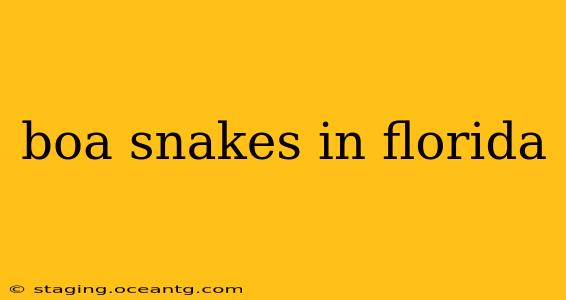Florida's warm climate makes it a surprisingly hospitable environment for a variety of exotic animals, and among them is the boa constrictor. While some boa constrictors are native to parts of South America and other tropical regions, the presence of these non-native snakes in Florida presents a complex ecological issue. This guide explores the realities of boa constrictors in the Sunshine State, addressing common concerns and providing crucial information for residents and visitors alike.
Are Boa Constrictors Invasive in Florida?
Yes, boa constrictors are considered an invasive species in Florida. They are not native to the region and their presence poses a significant threat to the native ecosystem. Unlike native snakes that have evolved alongside other species, boa constrictors can disrupt the delicate balance of Florida's wildlife, leading to potential declines in native animal populations. Their size and predatory nature make them a formidable presence in the state's diverse habitats.
What Types of Boa Constrictors Are Found in Florida?
The most commonly encountered species in Florida is the common boa constrictor (Boa constrictor). However, it's important to note that other boa species might be present, though less frequently. Identifying the specific species requires expertise in herpetology. If you encounter a boa constrictor, it's best to avoid handling it and contact local wildlife authorities.
How Did Boa Constrictors Get to Florida?
The introduction of boa constrictors to Florida is largely attributed to the pet trade. Escaped or released pet snakes have established breeding populations, contributing significantly to their spread across certain regions. Additionally, accidental releases or intentional abandonments have also played a role in establishing these invasive populations.
Are Boa Constrictors Dangerous to Humans?
While boa constrictors are not venomous, they are capable of inflicting a painful bite if they feel threatened. Their size allows them to constrict prey, and although attacks on humans are rare, they can occur, especially if the snake feels cornered or threatened. It's crucial to maintain a safe distance from any encountered boa constrictor.
What is the Florida Fish and Wildlife Conservation Commission (FWC) Doing About Boa Constrictors?
The FWC is actively involved in managing the invasive boa constrictor population. Their efforts include research, monitoring, and public education programs aimed at controlling the spread of these snakes and minimizing their impact on the ecosystem. The FWC also encourages the public to report sightings to aid in their efforts.
How Can I Protect Myself and My Pets from Boa Constrictors?
Protecting yourself and your pets involves understanding boa constrictor behavior and taking preventative measures. Keep pets indoors, especially at night, and be aware of your surroundings, especially in areas with known boa constrictor populations. Secure any potential entry points to your home, and learn to identify boa constrictors to avoid accidental encounters.
What Should I Do If I See a Boa Constrictor?
If you encounter a boa constrictor, do not attempt to handle or capture it. Maintain a safe distance and contact the Florida Fish and Wildlife Conservation Commission (FWC) or your local animal control authorities. They are equipped to handle these situations safely and effectively.
What is the Impact of Boa Constrictors on Florida's Ecosystem?
The impact of invasive boa constrictors on Florida's ecosystem is a subject of ongoing research. However, concerns exist about their predation on native wildlife, potentially causing declines in certain animal populations. Further studies are needed to fully understand the long-term consequences of their presence.
This information is for educational purposes and does not constitute professional advice. Always consult official sources and wildlife professionals for accurate and up-to-date information regarding boa constrictors in Florida.
